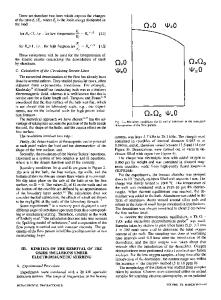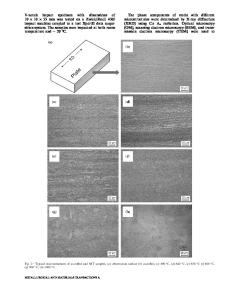Effects of Electromagnetic Stirring on the Microstructure and High-Temperature Mechanical Properties of a Hyper-eutectic
- PDF / 1,760,698 Bytes
- 5 Pages / 593.972 x 792 pts Page_size
- 2 Downloads / 472 Views
Heat and wear resistance are important mechanical properties for the piston head, which is a key part of an automobile engine, due to the friction between the cylinder liner and the piston head owing to the highstroke cycles. The piston parts based on the Al-Si eutectic system are generally manufactured through gravitational metal mold casting, and the mechanical properties are improved by adding Cu, Ni, Mg, etc.[1,2] Although inner defects such as porosities and blisters can be prevented by gravitational metal mold casting, there are significant problems in the metal mold casting process, such as the high post-processing cost and the low productivity. In addition, the microstructural evolution, which is related to the mechanical properties, cannot be easily controlled. In order to overcome these problems, studies on the applications of commercial near-eutectic and hypoeutectic Al-Si alloys for rheo-diecasting were reported.[3–13] However, the industrial application of rheo-diecasting using near-eutectic Al-Si piston alloys is difficult due to the narrow temperature range of processing. The rheo-diecast products using hypo-eutectic Al-Si alloy provide better mechanical properties, but higher
YOUNGSOO JANG, BYOUNGHEE CHOI, and BYUNGKEUN KANG, Ph.D. Candidates, and CHUN PYO HONG, Professor, are with the Department of Materials Science and Engineering, Yonsei University, 50 Yonsei-ro, Shinchon-dong 134, Seodaemun-gu, Seoul 120-749, Korea. Contact e-mail: [email protected] Manuscript submitted July 14, 2014. Article published online December 24, 2014. METALLURGICAL AND MATERIALS TRANSACTIONS B
coefficient of thermal expansion. A low thermal expansion coefficient essential for piston heads because of increased frictional heat generated by the piston movement inside the cylinder liner with excessive expansion. It is well known that the coefficient of thermal expansion decreases with higher Si content.[14] Thus, the hypereutectic Al-Si alloys may provide lower coefficient of thermal expansion compared to the hypo-eutectic and near-eutectic Al-Si alloys, while maintaining sufficient mechanical properties. In the present study, the manufacturability of piston heads using a hyper-eutectic Al-Si alloy with the liquidtreated diecasting method was evaluated, in which electromagnetic (EM) stirring was applied during cooling. The effect of process conditions in the liquid-treated diecasting method on microstructural evolution was investigated. The mechanical properties including the high-temperature tensile property, hardness, wear resistance, and thermal expansion were estimated and compared with those by typical gravitational metal mold casting. Cu and Ni were added (with amounts similar to those in the commercial piston alloys) for the samples of the present study to obtain increased heat resistance and high-temperature strength. The Si content was set at 15 wt pct to achieve high wear resistance and low thermal expansivity compared to the near-eutectic AlSi piston alloys at 12 wt pct. The chemical composition of the hyper-eutectic Al-Si-
Data Loading...











